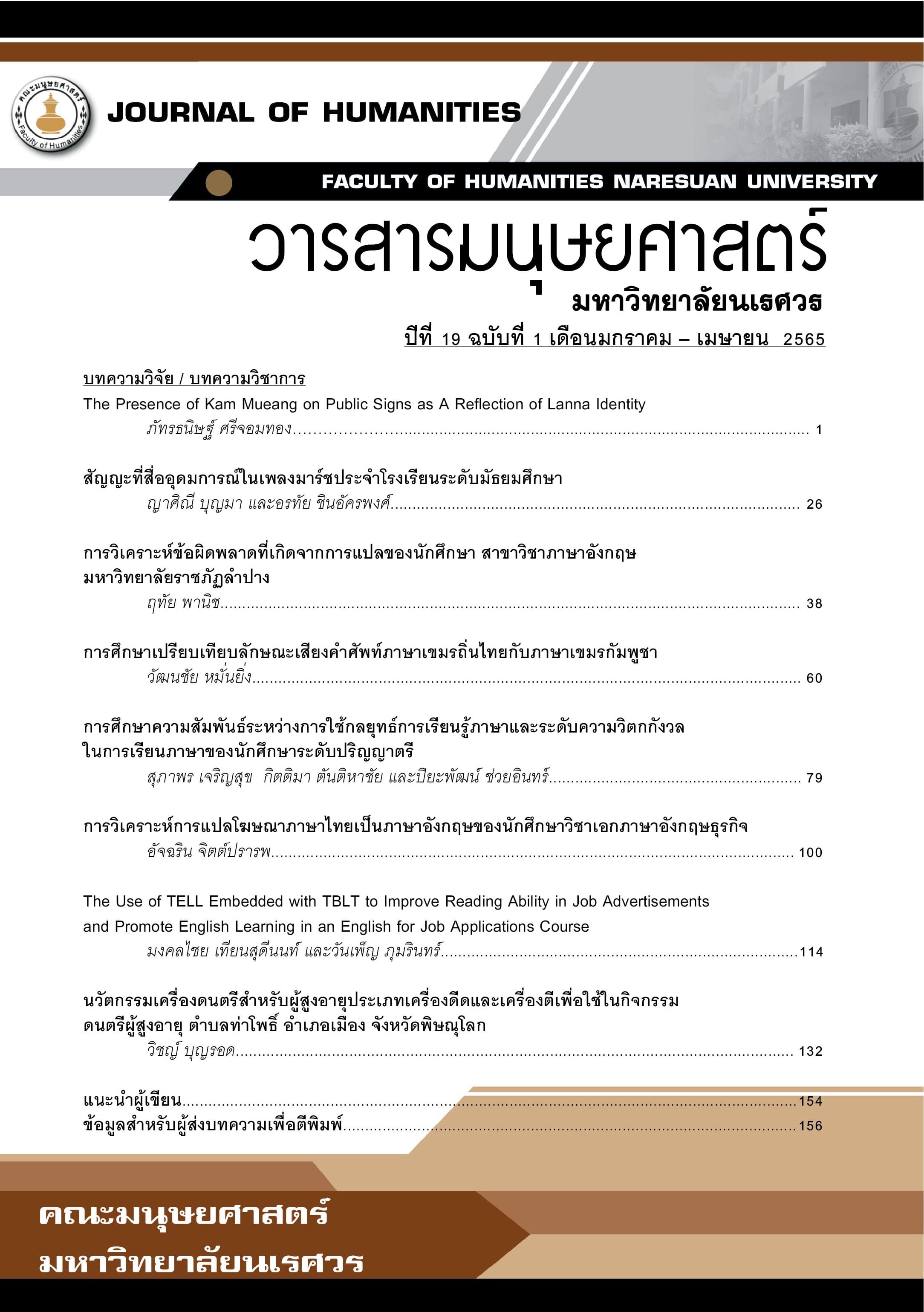การใช้เทคโนโลยีสนับสนุนการเรียนภาษาร่วมกับรูปแบบการสอนแบบเน้นงานเพื่อพัฒนาทักษะการอ่านภาษาอังกฤษในสื่อโฆษณา และส่งเสริมการเรียนรู้ภาษาอังกฤษในรายวิชาภาษาอังกฤษเพื่อการสมัครงาน
Main Article Content
บทคัดย่อ
วัตถุประสงค์ของงานวิจัยนี้ศึกษาการใช้เทคโนโลยีสนับสนุนการเรียนภาษา (Technology–Enhanced Language Learning-TELL) ในรูปแบบการสอนแบบเน้นงาน (Task-Based Language Teaching-TBLT) เพื่อพัฒนาทักษะการอ่านภาษาอังกฤษในสื่อโฆษณารับสมัครงานและส่งเสริมการเรียนรู้ภาษาอังกฤษในรายวิชาภาษาอังกฤษเพื่อการสมัครงาน โดยศึกษากับนักศึกษาระดับปริญญาตรี สาขาวิชาการจัดการทั่วไปที่ลงทะเบียนเรียนวิชานี้ จำนวน 80 คน จากมหาวิทยาลัยแห่งหนึ่งในจังหวัดปทุมธานี โดยการเก็บข้อมูลวิจัยในครั้งนี้เป็นวิธีแบบผสมผสาน คือเก็บข้อมูลจากแบบทดสอบการอ่านก่อนและหลังทั้งกลุ่มควบคุมและกลุ่มทดลอง อีกทั้งสำรวจข้อมูลจากแบบสอบถามและแบบสัมภาษณ์ ผลวิจัยพบว่า มีความแตกต่างระหว่างกลุ่มควบคุมและกลุ่มทดลองอย่างมีค่านัยสำคัญทางสถิติ นักศึกษาส่วนใหญ่อธิบายว่า การใช้เทคโนโลยีสนับสนุนการเรียนภาษา (TELL) และการสอนแบบเน้นงาน (TBLT) สามารถช่วยพัฒนาการเรียนรู้ภาษาได้
Article Details

อนุญาตภายใต้เงื่อนไข Creative Commons Attribution-NonCommercial-NoDerivatives 4.0 International License.
ข้อความรู้ใด ๆ ตลอดจนข้อคิดเห็นใด ๆ เป็นของผู้เขียนแต่ละท่านโดยเฉพาะ คณะมนุษยศาสตร์ มหาวิทยาลัยนเรศวร และกองบรรณาธิการวารสารมนุษยศาสตร์ฯ ไม่จำเป็นต้องเห็นพ้องด้วย
เอกสารอ้างอิง
Annamalai, N. (2019). The use of web 2.0 technology tools and beyond in enhancing Task Based Language Learning: A case study. The English Teacher, 48(1), 29-44.
Chen, T., & Lin, C. (2018). Enhancing L2 English learning through mobile - assisted TBLT: EFL learners’ perspectives. The Journal of Asia TEFL, 15(2), 453-461.
Chen, S., & Jing, W. (2019). Effects of the Task – Based Language Teaching (TBLT) approach and language assessment on students’ competences in intensive reading course. English Language Teaching, 12(3), 119-138.
Dörnyei, Z. (2001). Teaching and researching motivation. Harlow, England: Longman.
Hourigan, T., & Murray, L. (2010). Using blogs to help language students to develop reflective learning strategies: Towards a pedagogical framework. Austrian Journal of Educational Technology, 26(2), 209-225.
Kendra, C. (2019). The Zone of Proximal Development as defined by Vygotsky. Retrieved 16 December, 2019, from https://www.verywellmind.com/what-is-the-zone-of-proximal-de velopment-2796034
Maley, A. (2016). Principles and procedures in materials development. In M. Azarnoosh et al. (Eds). Issues in materials development. Boston: Sense Publishers.
Meesuk, P. (2020). Educational Research (2nd Ed.). Bangkok: Triple Education.
Nunan, D. (1989). Designing tasks for the communicative classroom. New York: Cambridge University Press.
Nunan, D. (2004). Task-based language teaching. Cambridge: Cambridge University Press.
Office of the Prime Minister. (n.d.). The Twelve National Economic and Social Development Plan (2017-2021). Retrieved 16 December, 2019, from https://www.nesdb.go.th/nesdb_en/ewt _w3c/ewt_dl_link.php?nid=4345
Richards, C. J., & Rogers, S. T. (1999). Approaches and methods in language teaching (2nd Ed.). USA: Cambridge University Press.
Schrooten, W. (2006). TBLT and ICT: Developing and assessing interactive multimedia for Task-Based Language Teaching. In K. van den Branden (Ed.), Task - Based Language Education from theory to practice (pp. 129-150). Cambridge: Cambridge University Press.
Teeler, D., & Gray, P. (2000). How to Use the Internet in ELT. Malaysia: Bluestone Press.
Vacca, L. J., Vacca, T. R., & Gove, K. M. (1995). Reading and Learning to Read. USA: RR Donnelley & Sons Company.
Van den Branden, K. (2006). Task - Based Language Education from theory to practice. Cambridge: Cambridge University Press.
Zhou, Y., & Wei, M. (2018). Strategies in technology - enhanced language learning. Studies in Second Language Learning and Teaching, 8(2), 471-495.


